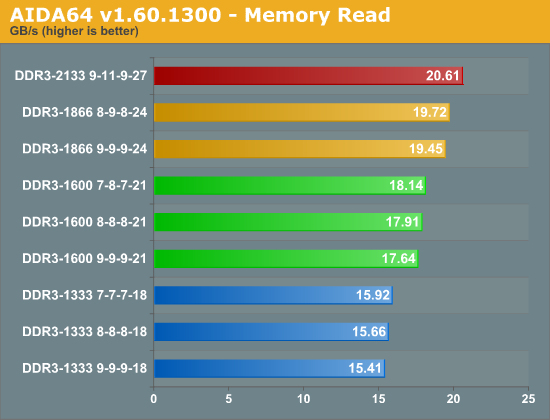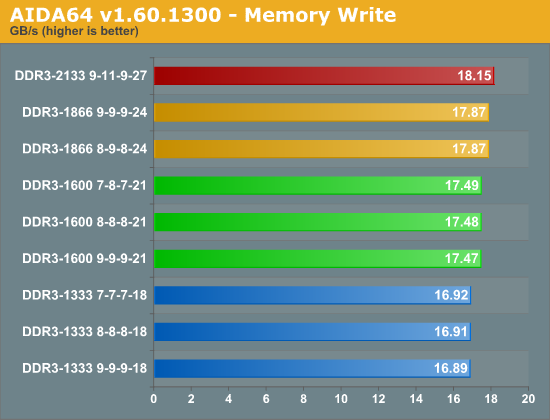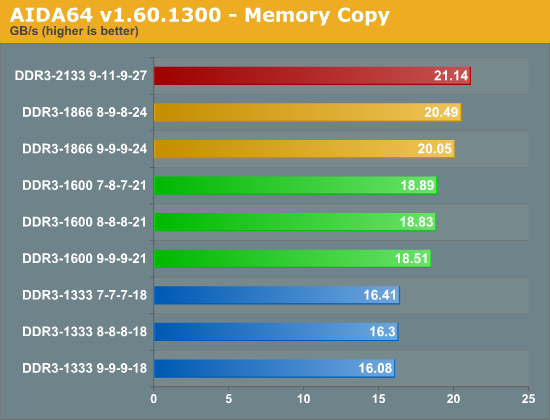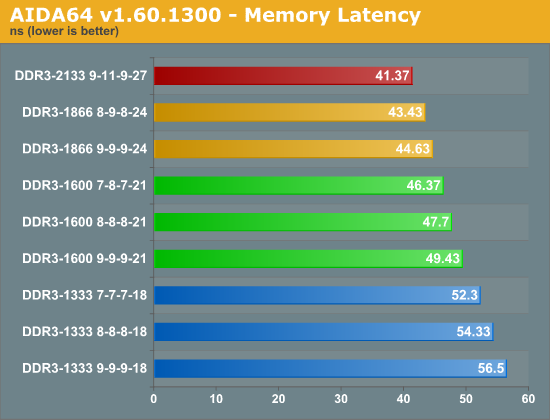Sandy Bridge Memory Scaling: Choosing the Best DDR3
by Jared Bell on July 25, 2011 1:55 AM ESTAIDA64 Memory Benchmark
AIDA64 provides a basic synthetic benchmark for comparing the read, write, and copy performance of system memory while also measuring latency. This should provide us the raw bandwidth for each memory configuration that was tested. Later on, we'll see how this translates into real world performance.




Our preliminary results show us the expected memory scaling. The faster DDR3-2133 memory has a ~36% advantage over the slowest DDR3-1333 memory in the read test, and the copy and latency tests show similar results. However, the write test closes the gap with only a ~7% difference between the fastest and the slowest. Overall, we see a linear performance increase as the memory clock speed is raised as well as when the CAS latency is lowered. Synthetic tests are really the best-case scenario, so let's move on to find out how the extra raw bandwidth affects our other tests.










76 Comments
View All Comments
Rajinder Gill - Friday, July 29, 2011 - link
LOL!Caught with your pants down there sir.
Isaac the k - Tuesday, August 2, 2011 - link
Memory above DDR3-1333 is plentiful and cheap.Sandy Bridge benefits from the bump up to 1600.
Mobo's all can handle the higher spec'ed memory.
WHY IS INTEL SPEC'ING THE NEW I7's FOR 1333 INSTEAD OF 1600 BY DEFAULT?
I don't want to have to futz with my BIOS just to get my memory to run at STOCK timings!
Why the HELL are they crippling the basic utility of their chips??
I grant you, it isn't a major increase in performance, but why set the ceiling so low? why not set it higher and let the mobo manufacturers choose what their boards are compatible with???
shriganesh - Wednesday, August 24, 2011 - link
This article is thoughtful and very good news for mid-end to high-end system builders :)There's absolutely no need to pay extra for those faster and better memory modules!!
ryedizzel - Tuesday, September 20, 2011 - link
Thank you very much for this article. I have been memory shopping for a couple days now and debating on different memory speeds vs. latency vs. price. I wish I had the lab setup to test them all. Thanks again!James D - Monday, November 28, 2011 - link
On each speed type (1333, 1600, 1866 etc.) you used only slightly different timings! For example for speed 1333 Mhz you had:1) 7-7-7-18
2) 8-8-8-18
3) 9-9-9-18
In this case of course you won't get much different results! Don't you know that changing CL and other timings you can change tRAS timings which is the minimum number of clock cycles needed to access a certain row of data in RAM between the data request and the precharge command.
OF COURSE you won't get big difference if you didn't change tRAS! If you lower all other timings then most likely you can decrease tRAS which also will increase performance.
Please rebench all these with slightly different all types of timings. It means a lot for results.
poohbear - Saturday, December 17, 2011 - link
Thanks for running the gaming benchmarks @ 1920x1080 to show us practical results (ie there were none!). i hate it when they run these benchmarks @ 800x600 or some nonsensical low resolution to show us a difference that we really could care less about in 2011.